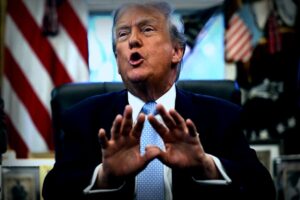So, it turns out President Trump has been making quite a buzz about a recent government analysis stating that his proposed tariffs could reduce federal debt by a whopping $4 trillion over the next decade. This is actually more optimistic than the forecasts from just a few months ago.
The president has been shedding light on the Congressional Budget Office report multiple times on Truth Social, using it to highlight what he sees as a key victory for his divisive policy measure.
“The tariffs are projected to bring in $4 trillion,” Trump declared at a recent Oval Office gathering, reiterating the report’s findings. He expressed frustration that this success wasn’t acknowledged earlier, claiming, “I knew this would happen but they didn’t want to give us the credit the first time.”
Here’s the catch: how much money the U.S. really collects hinges on a few vital factors. This includes whether these tariffs stick around until 2035 and how the economy reacts to them. There’s talk that tariffs could boost inflation and weaken the overall economy, which might shrink federal income, despite the CBO completely ignoring this in its analysis.
Furthermore, Trump has hinted at some tariff adjustments not covered in the report. For instance, he’s announced that products priced below $800 will lose their tariff-free status. Plus, there’s a federal appeals court looking into whether Trump overstepped his bounds in imposing many tariffs, so some of them might just get reversed.
Also worth noting, the One Big Beautiful Bill, part of Trump’s national strategy signed last month, is actually expected to add around $4.1 trillion to the federal debt from 2025 to 2034, which overshadows the projected intake from tariffs.
Diving into the Tariff Details
Since he took office in January, Trump has imposed tariffs on a slew of products from various countries. This includes ramping up tariffs on most Chinese imports by 30%, automotive products by up to 25%, and a staggering 50% on imports of steel and aluminum. These tariffs are likely going to pump up prices on everyday items like electronics, clothing, toys, and frankly, a lot more. Trump has insisted, though, that foreign governments are footing the bill for this increase.
The updated CBO projections suggest these tariffs could lower the federal deficit by around $3.3 trillion and shave off about $700 billion in interest costs, bringing it all to $4 trillion – but again, that included estimates made in August.
Earlier this June, the CBO projected the initial round of tariffs would cut the debt by about $3 trillion, so this is quite a shift. It’s important to remember that Trump has frequently changed the tariff percentages for different products and countries.
For instance, he initially slapped a 20% tariff on China, which he then massively hiked to 145% shortly after China retaliated. Following negotiations, both nations came to an agreement to somewhat lower their rates, with the U.S. keeping a minimum of 30%, but continuing increases could be on the horizon if China doesn’t cooperate on rare-earth minerals.
Interestingly, Trump recently expressed interest in using some tariff revenues for things like rebate checks to residents, but Treasury Chief Scott Bessent clarified that any money would likely go toward settling the national debt instead.
Up until August 22 this year, tariffs and customs duties have amassed nearly $156 billion in revenue, as reported by the Treasury Department.
While this revenue level caught most by surprise, experts like Marc Goldwein from the Committee for a Responsible Federal Budget caution that any exceeding revenues might not hold if inflation spikes or an economic downturn occurs. He mentioned that previous CBO evaluations with economic impacts factored in suggest tariffs could ultimately reduce federal intake.
It all comes down to whether we experience minor economic blips or something more severe, and how well we adapt to this new normal with tariffs.
Contribution by CNN’s Elisabeth Buchwald to this write-up.




















